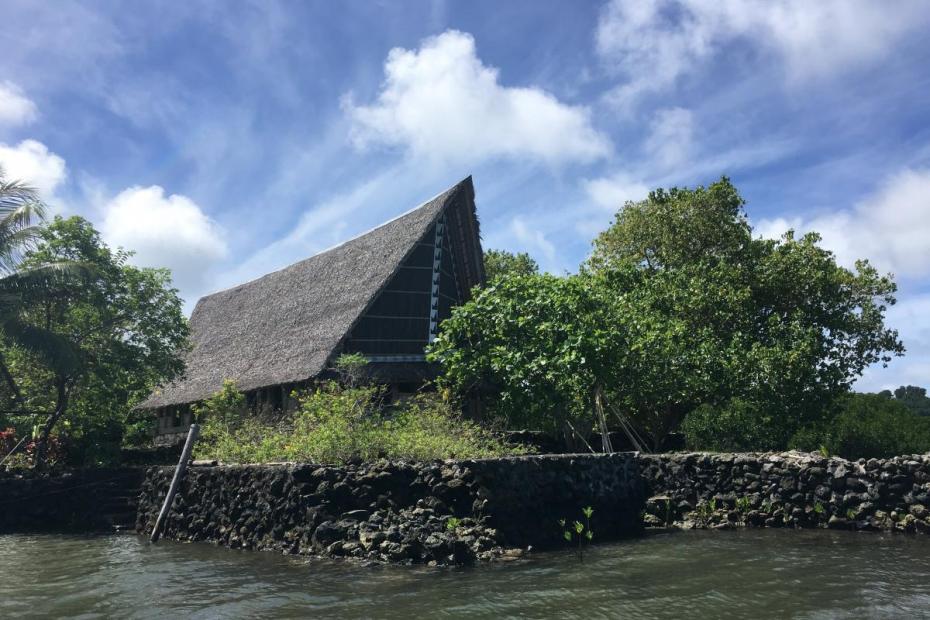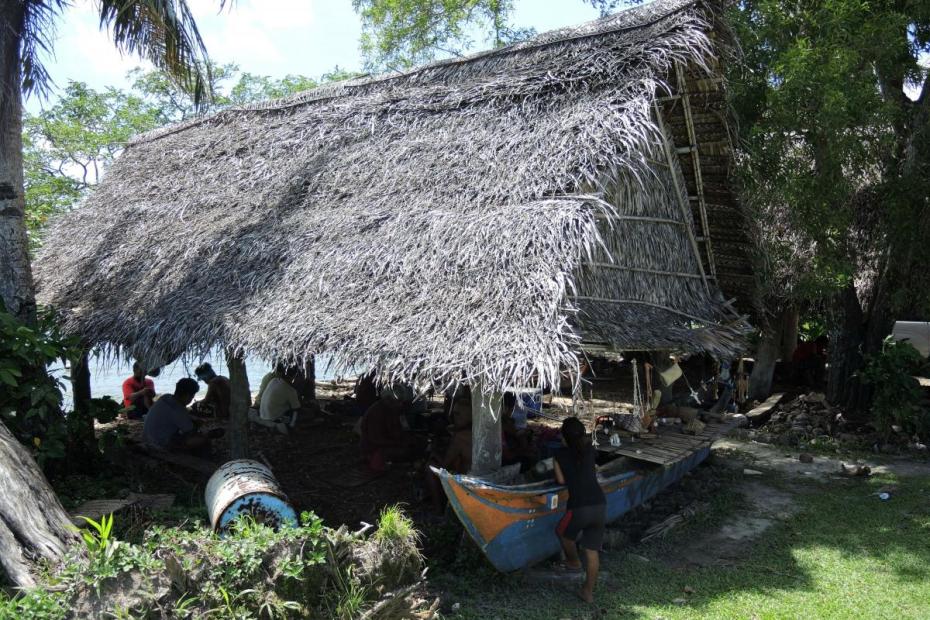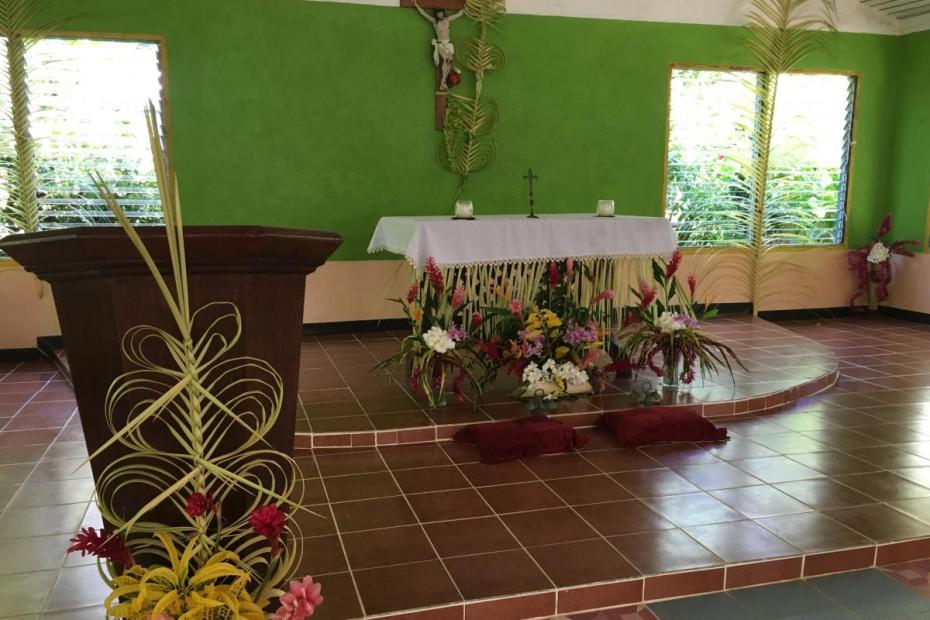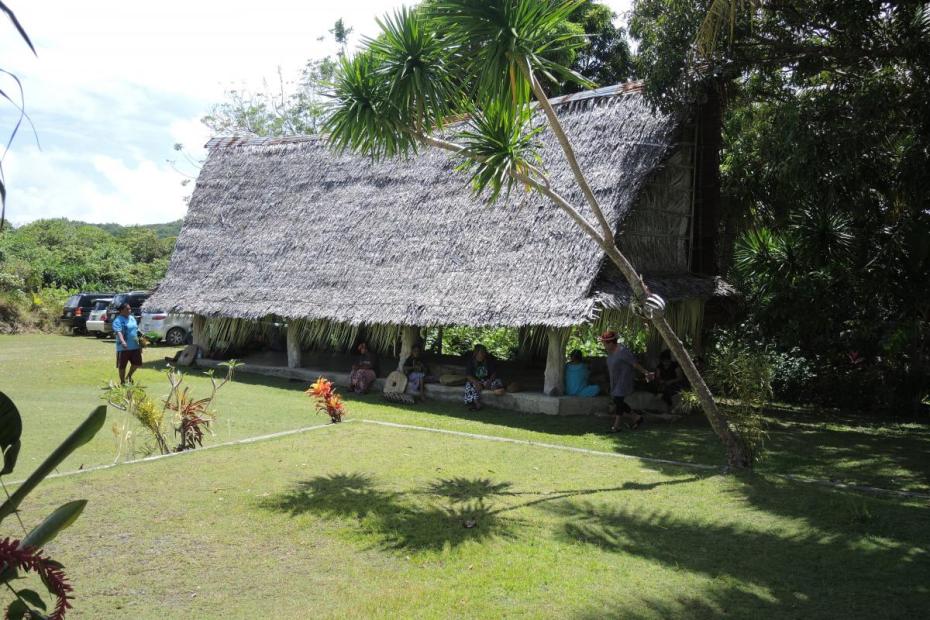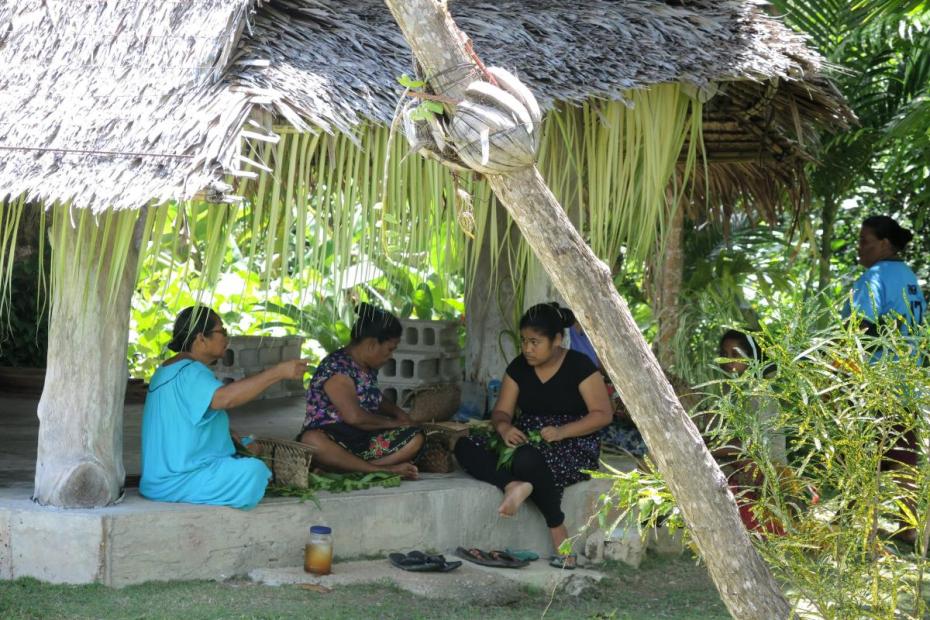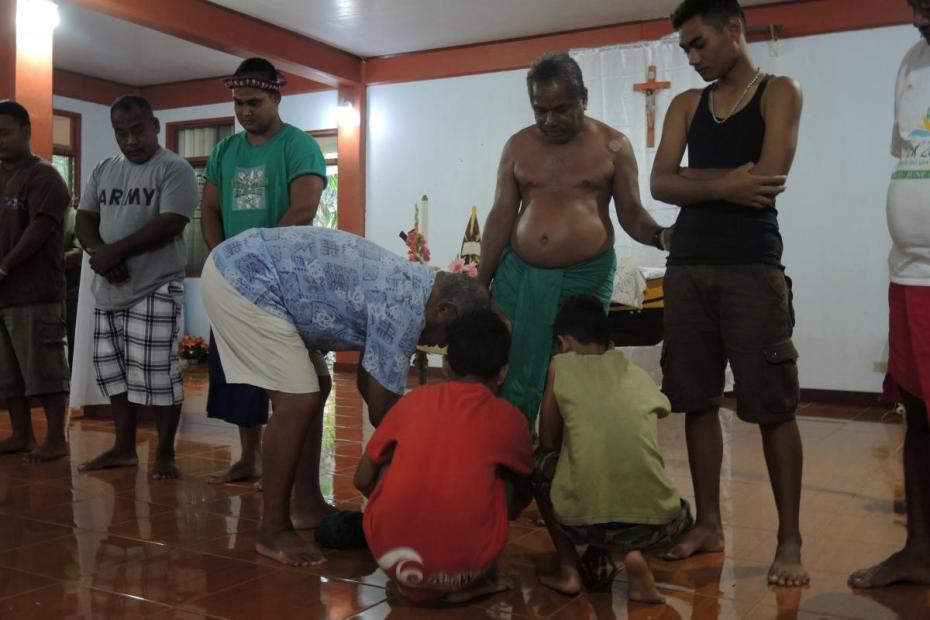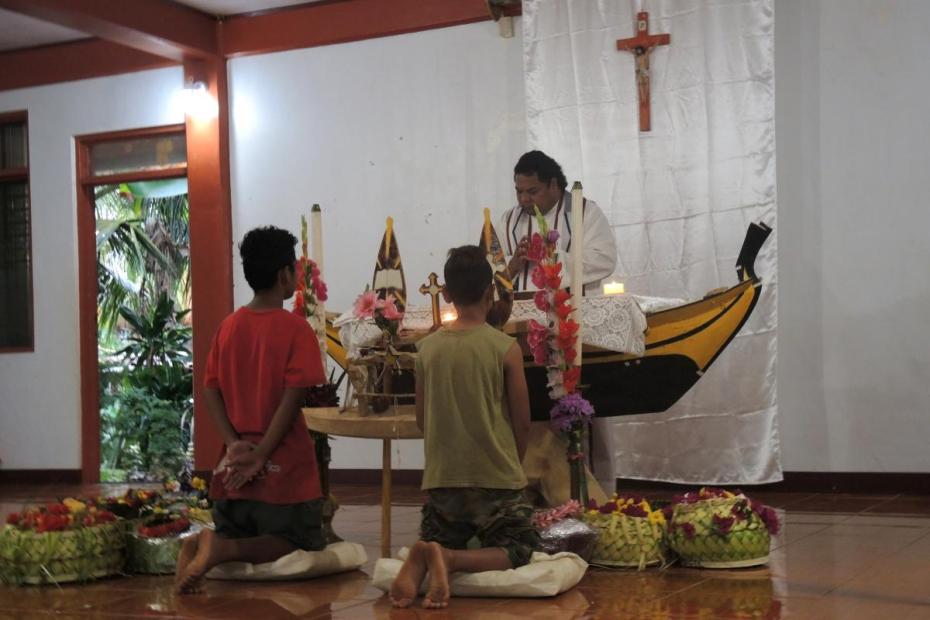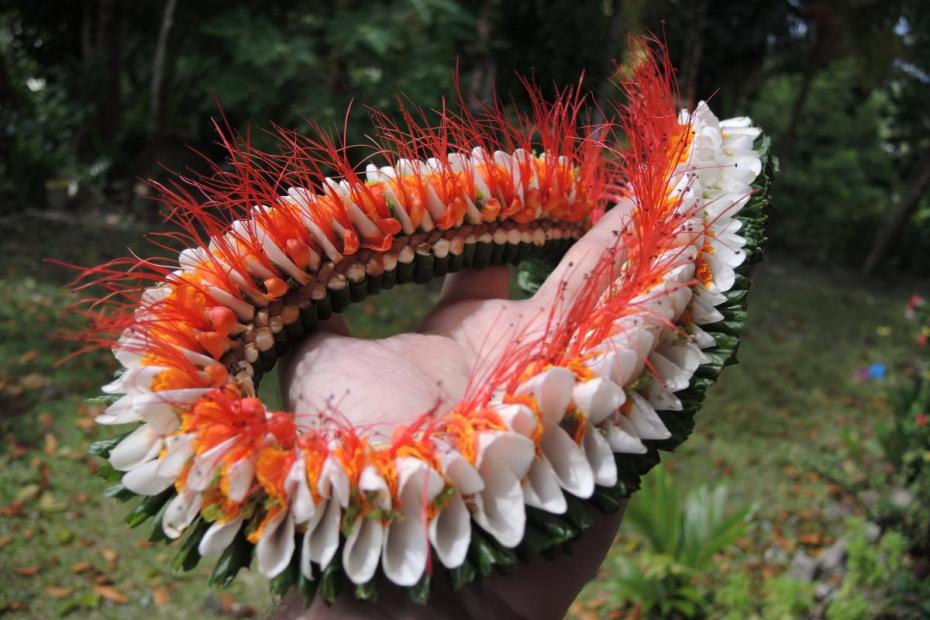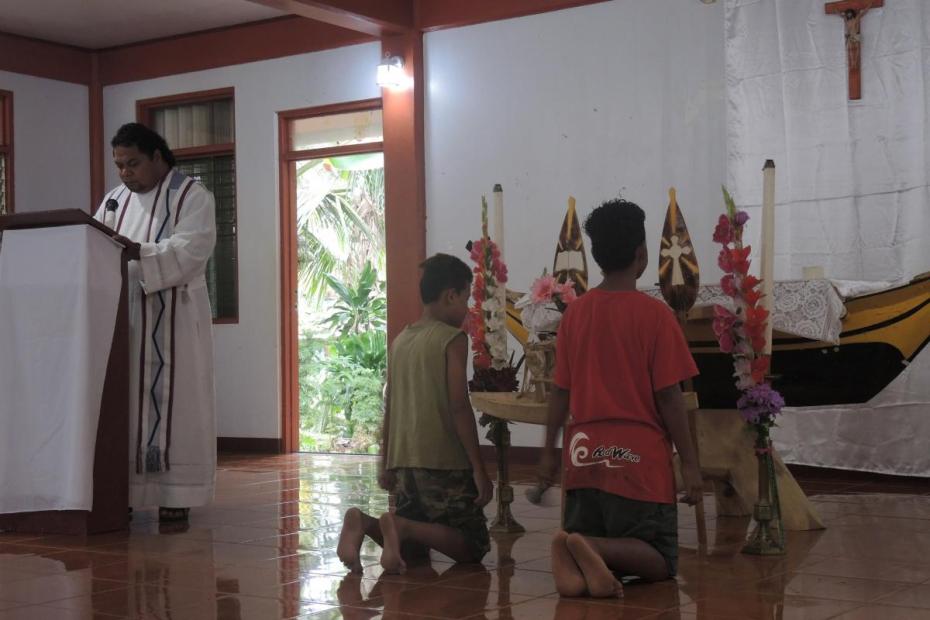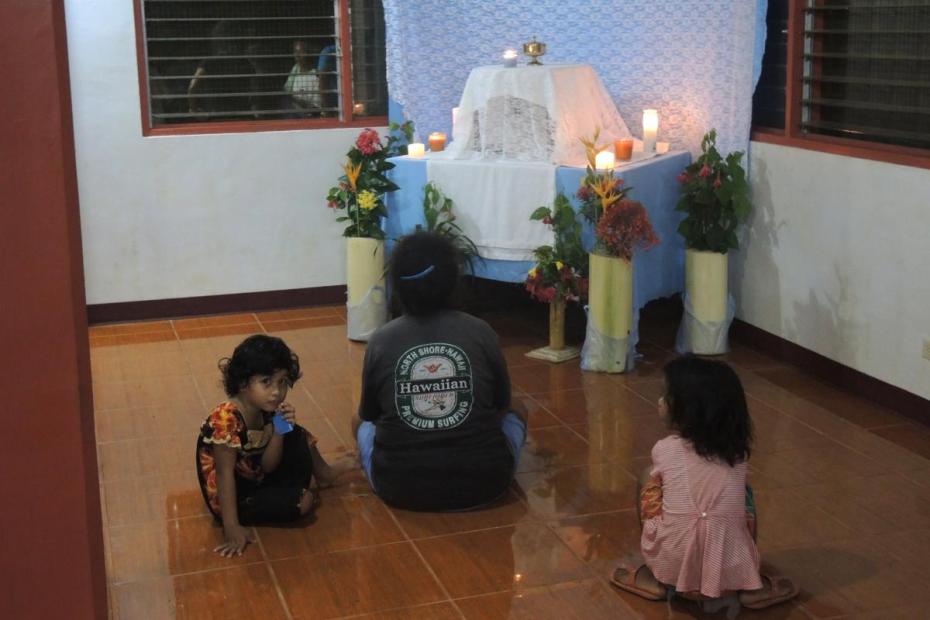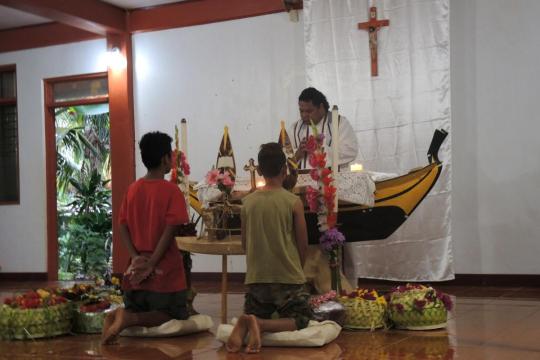Gender and family are almost certainly the most determinative elements of a person’s life on Yap and the Outer Islands.1 Though the rules may differ from island to island—Yap proper is traditionally a patrilineal society, whereas Outer Islanders’ cultures, like most of the rest of Micronesia, are traditionally matrilineal—the rules are clear and indisputable.2 Women and men have fixed tasks. In Yap proper, men fish, build and maintain houses, build boats, harvest betelnut and coconuts, and help with heavy digging for yams. Women prepare food; plant and harvest taro; weed the gardens and clear the road in the village; cook; weave baskets, grass skirts, and roof thatching; and teach children how to behave. In the capital, where some people earn their living through wage labor at jobs, this social arrangement is changing to some degree, but such people are still a minority of the population, and the effect in Yap seems to be smaller so far than in some other capital towns in Micronesia. What it means to be a man or a woman is still largely fixed to work and social responsibilities.
Faluws, men’s houses, are an enduring institution in Yap. These tall, thatched, peak-roofed buildings on stone platforms dot the coast (at least one of them on Yap is now built of stronger materials, but in the same form). Men gather there to plan their fishing and other tasks, and these were the places in the past where any visitor from another island was required to arrive. Women are still forbidden from entering the men’s houses.3
At one time women were required to stay in women’s houses during their menstrual period, but that requirement has been eliminated, apparently under pressure from the Church, because they kept women from attending Mass. In the center of any village today, and often next to Catholic churches, Pe'bai, or community houses, are built for meetings and other gatherings. These are open to men, women and children.
Decision making on Yap is always a communal process, but only senior men are allowed to speak publicly in meetings. Younger men, and women, have no public say. They do have private opportunities for input, and if they see the men going astray, can collectively protest to the chief, but this is unusual.
Land, which belongs to the lineage and is apportioned to families, is essential to Yapese people’s sense of identity. A person’s Yapese name (Yapese typically have both a Yapese name and a Christian name, but not a “last” name) refers to the piece of family land where the person was born. In contrast to most of Micronesia, land use is passed down patrilineally, though it belongs to the lineage. Women move to their husband’s land when they marry, and have a right to stay there as widows, unless they remarry. (In the Outer Islands, families usually follow the Chuukic rules, wherein land is held by the matrilineal line.)
Yap had a Western-style democratic government that operates alongside traditional systems. While its highest elected level of leadership is all male, a number of positions below that, including on the governor’s cabinet, are now occupied by women. Many teachers are women.
Marriage
Norms for marriage and family are overwhelmingly determined by “traditional,” i.e. Yapese norms. Missionaries have made very little headway on the issue. As one Catholic woman interviewee described it, “only 1 or 2% of marriages start right off with a church marriage.” Rather, almost all take traditional form, whereby the couple visits the bride’s mother and offers a small amount of money, after which the community recognizes the couple, and the couple can move in together. (In a traditional divorce, the process would simply be reversed). Many couples live that way for their whole lives. The choice of a partner is increasingly one that the couple can make, though there are taboos about choice of a marriage partner, particularly that the partner not come from the same clan. Even clearing that hurdle, though, if one family does not approve the match, it is not possible.
Civil marriage is the second step for most couples, and often occurs when families need government paperwork to document familial relations, say for passport or migration or benefits. Church marriage is typically the last stage, even for Catholics. Catholics are well aware of the church’s requirement that marriage be indissoluble, which is one of the things that makes it rare, or often requested only late in life.
As is true in other parts of Micronesia, public displays—even acknowledgements of affection—between spouses is never shown.4 In public, men tend to socialize with men, and women with women, and it can be difficult for an outside observer to know who belongs to which nuclear family.
One man from a small Yapese Outer Island claimed that homosexuality was so unknown, or at least so underground, that he felt sorry for anyone there who was homosexually oriented. “I’m not sure who they’d even have to turn to.” People were connected enough to global media to know about it elsewhere, but it was not apparently a source of concern in Yap.
Family
Children’s upbringing is designed to cultivate the values Yapese respect most: respect and deference to elders, self-control and management of feelings. As anthropologist Jason Throop observed,“a virtuous person in Yap is understood to be an individual who is able to sacrifice his or her individual desires, wants, wishes, feelings, opinions and thoughts to the dictates of the family, village and community.”5 Child rearing, past the time children are infants, does not put them at the center of attention or involve lavishing attention or teaching them that they are special. Children are taught to be self-deprecating, to take on the work roles that their gender proscribes, and in some cases are educated for more contemporary work tasks, but a paramount virtue in child raising is to instill the moral values of deference, self-control and modesty.6 Creativity, ambition, self-actualization, and adventurousness are not values to inculcate in children.
Even in a social system where families have clear boundary and behavior expectations, and people are expected to adapt their behavior to family expectations, interviewees did not idealize the situation of families. One interviewee pointed to funerals as the ritual occasion that forced families to come back together, as the time that required putting aside differences and coming together in reconciliation.
Historically, Yapese families, like many other Micronesian families, valued adopting other children into their families, in an act that did not mean renouncing a prior familial relationship, but adding to a child’s web of family relationships.7 That practice has declined, but children’s upbringing is still shared not only by parents and siblings, but by an entire lineage. The lineage has a say in the decisions affecting children. Indeed, in cases where a family member commits some crime or other offenses, the whole lineage is held to account, not simply the person who commits the crime. As of the 2000 census, Yapese women bore an average of almost five children each, slightly more than in the 1994 census.8 That number, though, is significantly fewer than a generation before, and is said to be declining.
Even during the process of death and mourning, gender roles—even one’s physical place at the event—are clearly defined by tradition.
Gender in church life
The post-Vatican II shift to women communion ministers was described to me as far less a matter of ecclesial adjustment than cultural adjustment in Yap. Once clergy first taught that the Church endorsed the practice, it took much more time for laypeople to adjust. In some outer island churches, women give communion to the sick and to other women, but would not be allowed to give communion to their “brothers,” a category of kinship that includes both brothers, cousins, and uncles, because it is taboo for a woman to feed one of those brothers.
Interestingly, Catholics adaptations of traditional cultural practices into worship give women, rather than men, added, prominent roles at the holiest moments of the church year—during the dance at Christmas, the wailing of the doloolow on Good Friday, and the dance of thanksgiving on Easter Sunday. These build on cultural traditions—wailing at funerals, and a particular form of chiefly dance—that traditionally belonged to women.
We might also consider how the decoration of churches is gendered. Just as the use of lace and flowers in a Western church entails bringing culturally feminine elements into the decoration of churches, much of the decoration of Yapese churches is composed of flowers and woven fronds. Most churches, of course, have images of Jesus and Mary, though one sub-parish had a large painted image of the Trinity, with large images of Jesus and the Father.
In the Catholic chapel at Gergey, which is used for Outer Islanders living in Yap proper, something notably different holds true. The altar is in the form of a traditional boat, and the processional cross is carved and enclosed in a traditional boat paddle. These are very gendered ways of defining the altar space, since in Outer Island cultures, gender roles are clear: Only men fish in and make those boats. Women’s decorations, though—weaving and cloth—are surely also part of the space.
Whatever the decoration, in a sharply gender defined society, there is hardly any agitation evident for greater women’s roles. Women do serve as lectors, altar girls, and in other church roles, but other kinds of ecclesial gender parity does not seem to be a substantial issue.
- 1The entries here are based on a week of participant observation on the main islands of Yap, interviews with 11 Yapese and Outer Island Catholics, and less formal discussions with a dozen others during Holy Week and part of Easter week, 2018.
- 2“Yap proper” refers to the four high, nearly contiguous islands of Yap (Waqab in Yapese) where the state capital is located and where the bulk of the population lives. Gender rules are comparable on the other islands that make up Yap state, but not explored in depth here.
- 3Before the Spanish missionaries arrived, the men’s houses were used as sites where select young women “provided sexual gratification for any and all of the men of the village,” a role that was considered an honor. The missionaries successfully put an end to this practice, even as they were far less successful in bringing church marriage into the culture. Francis X. Hezel, S.J., Strangers in their Own Land: A Century of Colonial Rule in the Caroline and Marshall Islands (Honolulu, University of Hawai’i Press, 1995), 22.
- 4See Francis X. Hezel, S.J., Making Sense of Micronesia: the Logic of Pacific Island Culture (Honolulu: University of Hawai’i, 2013), 136-139.
- 5C. Jason Throop, “‘Becoming Beautiful in the Dance’: On the Formation of Ethical Modalities of Being in Yap, Federated States of Micronesia,” Oceania, 79 (2009): 182.
- 6On the broader Micronesian pattern exemplified here, see Hezel, Making Sense of Micronesia, 127-135.
- 7On the practice across Micronesia, see Francis X. Hezel, S.J., The New Shape of old Island Cultures: a half century of social change in Micronesia (Honolulu: University of Hawai‘i, 2001) 28-32.
- 8Yap Branch Statistics Office, Yap State Census Report (2002): 36. Accessible at http://pacificweb.org/wp-content/uploads/2018/05/2000-Yap-Census-Report_Final.pdf.
